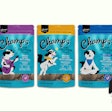
Fish4Dogs, a UK-based premium pet food company, has released an informational video on pet food-related skin conditions in dogs.
When alleviating food-related skin conditions in dogs, it is important to identify if the pet is suffering from an allergy or an intolerance. The symptoms of the two can be very similar but there are key differences, according to David Southey BSc in the video.
“An allergy is the immune system reacting to what it sees as a foreign or unusual protein, whereas an intolerance is often a secondary reaction that can be triggered by a variety of factors including the diet,” says Southey in the video.
The video identifies three main causes of food-related intolerance in dogs: nutrient imbalances, ingredient sensitivities and hyper-sensitivity.
Nutrient imbalances in pet food
The video advises pet owners to look for foods with high levels of high quality proteins and omega-3 fatty acids to avoid nutrient imbalances.
“Hair growth and skin keratinisation place heavy demands on proteins with around 25 percent of a dog's daily protein allowance being used for the maintenance of skin health,” says Southey. “So look for lots of high quality protein such as fish. All complete foods meet daily nutritional requirements for dogs but some do so with better, more nutritional ingredients and will result much better skin condition.”
Ingredient sensitivities and hyper-sensitivity conditions
With ingredient sensitivities, he suggests a similar approach with elimination diets to identify the causes. Hyper-sensitivity conditions need the correct balance of fatty acids.
“Hyper-sensitivities skin irritation and inflammation are caused by circulating chemicals known as series 1 eicosanoids. These compounds are by-products from the body's metabolism of omega 6 fatty acids, which are found in vegetable oils and chicken fat. A surplus of these omega 6 fats causes an increase in eicosanoids in the blood which puts the body in a state of alert, causing it to overreact to small disturbance in the diet. Omega 3 can counteract the effects of omega 6 putting the body back into balance by producing anti-inflammatory series three and five eicosanoids,” says Southey.
The ideal ratio of omega 6 to omega 3 is a matter of debate between animal nutritionists. Some argue it should be a one-one ratio, but the consensus is that a ratio between five-to-one and ten-to-one is optimal.
Southey comments that many pet foods are over-rich in chicken and vegetable oil, which tip the balance and result in dogs consuming too much omega 6.
“Some of these foods have ratios well in excess of 20 or even 30 to one. Feeding a high-quality fish-based food or supplementing with a small quantity of pure fish oil is the most effective way of achieving balance,” says Southey.
















